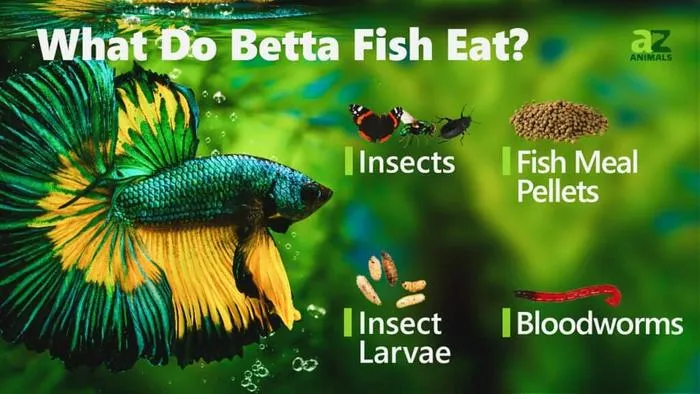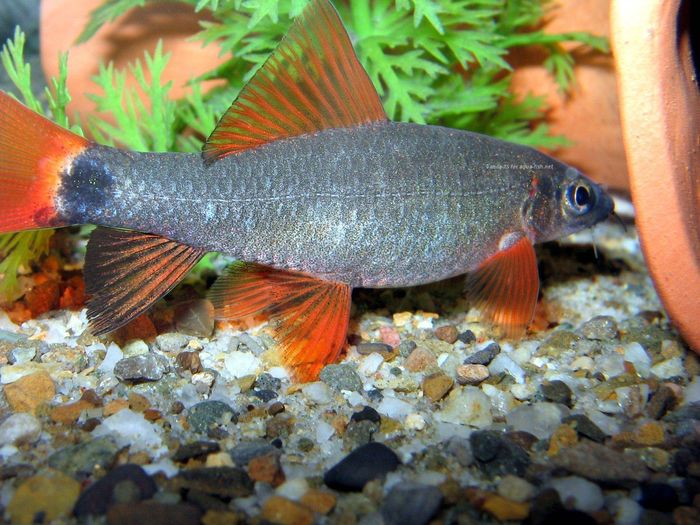If you are looking for fun fish that do not require much space, I highly recommend Clown Killifish species. If you have a small tank or want to add a quiet little community fish to your collection, Clown killifish may be something you are looking for.
These little fishes add a splash of color to the tank. They are relatively easy to keep and grow in captivity. Clown killifish are top residents, so if you have a Nano tank and are looking for something to fill in the overlooked section, these micro predators are a great choice.
This article will cover everything you need to know about keeping Clown killifish happy and healthy. I will discuss their natural habitats and origins so that you can provide them with optimal conditions and care to reach their full potential in your home fishery.
Clown Killifish Care Guide 2023
- Common Name: Clown Killifish, Clown Killie
- Binomial Name: Epiplatys Annulatus
- Synonyms: Haplochilus Annulatus, Aplocheilus Annulatus, Panchax Annulatus, Pseudepiplatys Annulatus
- Kingdom: Animalia
- Phylum: Chordata
- Class: Actinopterygii
- Order: Cyprinodontiformes
- Family: Nothobranchiidae
- Genus: Epiplatys
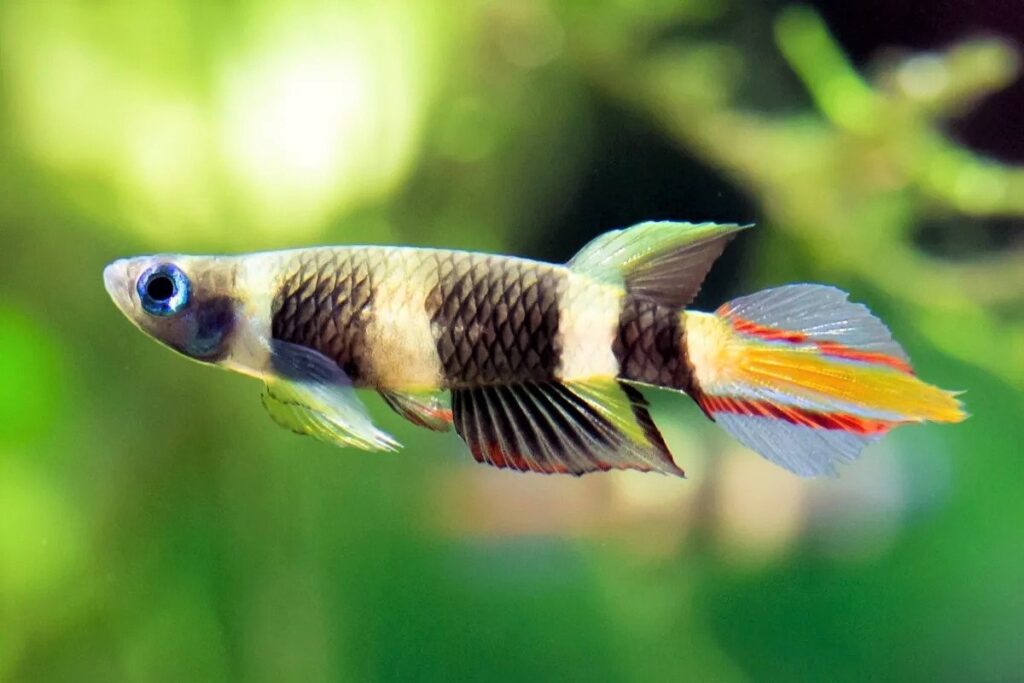
The clown killifish was given the name Haplochilus annulatus in 1915 by Boulenger, but it has surpassed the currently recognized scientific name, Epiplatys annulatus. This fish is also commonly known as banded panchax, rocket panchax, and rocket killifish. Killifish belongs to the family Nothobranchiidae and lives in tropical, freshwater habitats in West Africa, Liberia, Guinea, and Sierra Leone.
Natural Habitat
Clown killifish habitat in areas with open savanna and tropical rainforests like low-lying swamps, slow-moving streams, and small rivers. Although most habitats are freshwater, in some places, it is slightly saline. The climate in its range is hot and humid, with an unusual wet season between April-May and October-November. The water is generally warm, soft, and acidic, but the primary rainforest has protected forest reserves in many cases.
Causeway is one such reserve in the Moyamba district of Sierra Leone. It covers part of the rocky volcanic mountains covered with moist, semi-deciduous, and evergreen forests. These little preys are abundant in streams, swamps, and water holes that were once known for the clown killies home in their natural habitat.
Clown Killifish Care
The most difficult part of Clown killifish care is maintaining a subtle balance of low water flow and cleanliness. If you do not use a filter, make a 50% water change every few days. If you are using a filter, spread the flow with a garnish or plant in front of the filter. With or without a filter, make sure you have plenty of plants on hand to absorb harmful ammonia and nitrates. Floating plants serve more properly to help keep your tank clean. Clown killi love to swim through floating plants’ leaves and rely on them to reproduce because they act as spawning mats.
If water conditions are compromised at any time, the chances of fish diseases will increase. Although clown killifish are very hardy, they are very small, so you may want to be careful in looking for signs of illness or disease.
Killifish Tank Size and Requirements:
Home entertainment enthusiasts should be well aware of their wild nature. It will help fish enthusiasts how to provide the right conditions for these small treasures. Since they are predators, you need to deliver live prey. Also, streams and swamps move very slowly, and clown killies need more water or slower currents.
Clown Killifish are small so that you can adjust 2 or 3 pairs in a 5 gallon tank or up to 8 pairs in a 10-gallon tank. You have to keep regularly at least 5 gallons of water in a tank. This water demand is significant for two reasons.
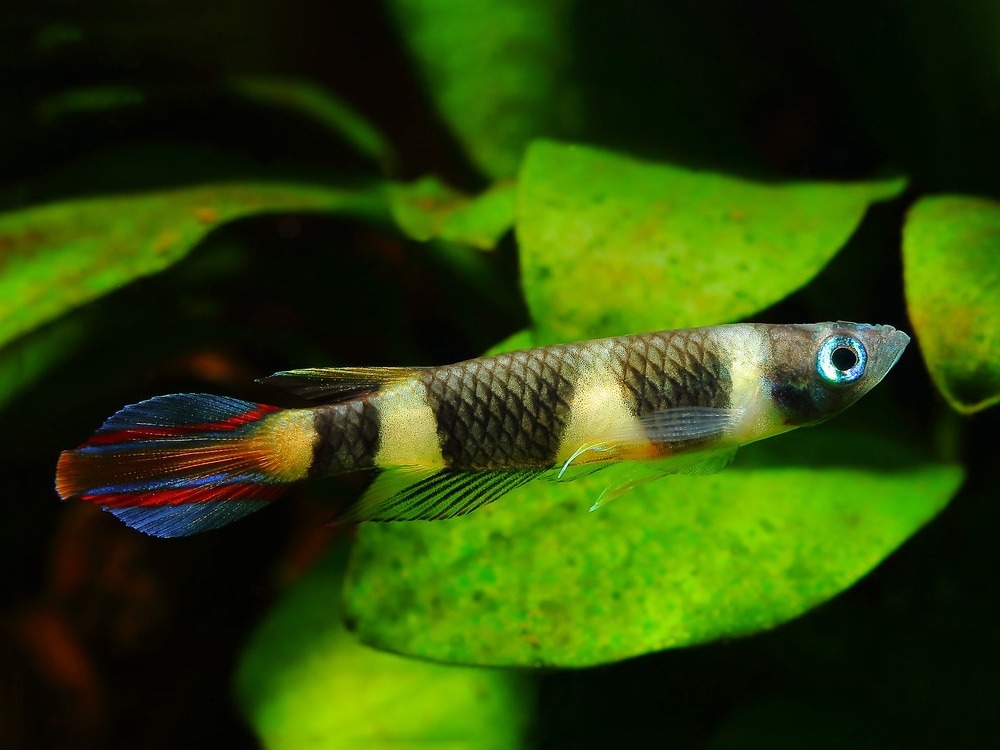
First, the cleanliness of the tank without the filter is very challenging. This is not much of a problem in the natural habitat because the water level is very large, but in a micro or Nano tank, keeping things clean can be challenging. If you do not have a filter, you will have to make regular water changes and plenty of grass and mosses to keep the water clean.
The second consideration is other fish habitats. A strong current is required for some lochs and tetras, so they may not be a good choice for clown killifish tank mates.
Water Conditions:
In the open waters, clown killifish enjoy warm and acidic soft waters, so you have to recreate these conditions in a home fishery. Maintain a water hardness of 50 ppm.
You can pre-condition the water before adding the fish. In a separate container, add the water and soak the charcoal in a box filter for a few days. The water will get an amber color, which is perfect for clown killi. Optimal parameters to ensure close compatibility with their natural habitats:
- pH levels: 4-7
- Water hardness: 4-8 DKH
- Water temperature: 68 ° – 79 F (20 ° – 26 C)
Maintaining these parameters will assure that you have a successful breeding killifish environment. Make sure you have enough plants in the water tank to absorb most of the ammonia and nitrates. Maintaining clean water will secure the health of your fish. If you use a filter, be sure to place plants or decorations in front of it to reduce the direct flow that prevents clown killifish. You can also choose a filter with a low flow and will not move water too much.
Killifish Size and Appearance
Epiplatys annulatus is small, measuring 1 to 2 inches long. The male killifish is very bright in color with a yellow and black striped body and exciting anal and spinal fins with red and blue lines. Female killifish is usually very modest in color, those who do not have the beautiful complexion of males and often small.

In shape, these fishes resemble a tiny bike, shaped like a rocket or torpedo, with a rounded head and an inverted mouth suitable for surface feeding. The dorsal fin is well positioned on the body, with the initial rays appearing above the fish’s anal. The calyx is in the shape of a spike with long central beams, especially the male lights up to the entire calf.
Enthusiasts who are well aware of clown killifish will know that they come in the majority size range of other killies. There are 1,270 different killifish types, ranging from 1 inch (2.5 cm) to 6 inches (15 cm). Most are 1-2 inches (2.5-5 cm), including clown killies. They are inhabitants of the United States since the 1960s, and although their name refers to their predatory habits, their true origin comes from the Dutch language.
Typical Behavior of the Clown Killifish
Please do not neglect the clown killifish or any other fish’s behavior and lifestyle before placing it in the small tank. Fishes have different natures. Some fishes are quiet, some aggressive. So, if you are keeping multiple creatures in a small fishing net, avoid putting them together. Clown killifish are peaceful fishes, but they are also predators. Instead of chasing their prey, they wait near the surface of the water.
When the unsuspecting insects escape to the surface, the clown killies snatch them up and catch them with their inverted mouths. They are more dangerous than other fishes, so you should not keep them with other small fishes unless you have a large fish for the tank. They are shy too, so the clown killifish works best in groups of 10 fish. When they are in groups, they are playful.
Speaking of the game, Clown Gillies are skilled jumpers, so it would be wise to maintain a tight-fitting tank for these little fishes. To keep them happy:
- Make sure the light is not too bright.
- The water current is still or too slow.
They will also appreciate a habitat similar to their own Africa’s streams and swamps. Under the right conditions, the killifish lifespan is about 5 years.
Single Fish VS Community:
In the captive environment of the tank, large fish can live on their own without community. Some fish prefer to live in a community of 5-6 species. Without a group, they cannot live and die early from the stress of being alone. Fish species come in different sizes, so before choosing a species, always look for the best fish for smaller tanks. 5-gallon tank fish are generally small and can be stressful if kept alone. Typically, keeping fish in an aquarium will take one fish per gallon of water. This is a common idea and may vary depending on the swimming and mood of the fishes. For best results, test your fish species by gradually adding fish to a small 5-gallon tank.
Clown Killifish Tank Mates
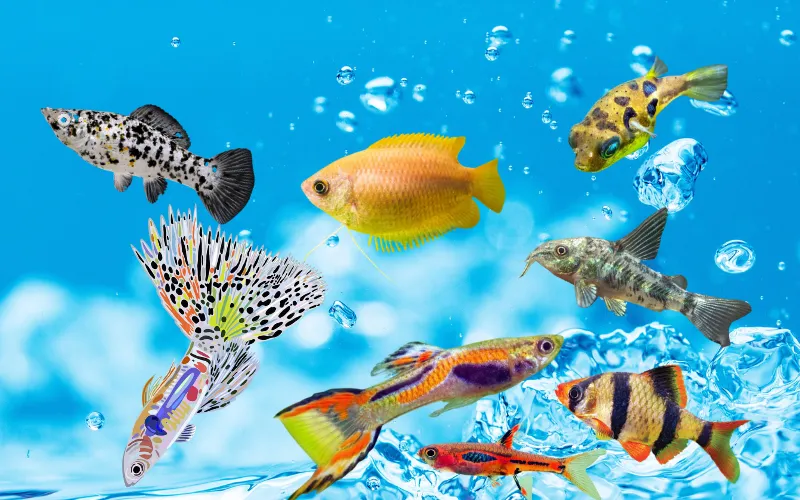
If you are not planning an exclusive tank for these little fish, choose small and quiet fishes to pair with the Clown killie. Some appropriate Killifish tank mates are
- Bettas
- Molly Fish
- Honey Gourami
- Corydoras Catfish
- Celestial Pearl Danio
- Sparkling Gourami
- Minnows
- Endler’s Livebearer
- Small Barbs
- Guppy Fish
- Small Plecos
- Neon Tetras
- Pea Puffer
- Chili Rasbora
It is also a good idea to choose medium and low-level feeders to go with the clown killifish. That way, they can keep the tank above themselves. Finally, small shrimp or snails are good tank mates because they help keep the water clean by eating leftover and harmful food. Carefully manage your tank to ensure that all species have suitable habitats and water conditions to thrive.
What do killifish eat?
A micro predator usually feeds on terrestrial and aquatic vertebrates and other zooplankton in their natural habitat. These fishes will accept the appropriate amount of dry food and daily small live and frozen foods such as Artemia nauplii, Daphnia, Moina, Grindle worm. The only catch is that they need small portions of meat protein like insects because they are small. They wait for the insects to land on the surface of the water and then move on to their prey. This is what they will eat in the woods, and this is what you should follow when you are keeping killifish. Try a combination of the following killifish foods 1-2 times a day:
- Microworms
- Copepods
- Mosquito Larve
- Small Daphnia
- Flour Beetles
- Flour Beetles Larvae
- Fruit Flies
- Baby Brine Shrimps
- Moina
- Walter Worms
- Vinegar Eels
- Small Grindal Worms
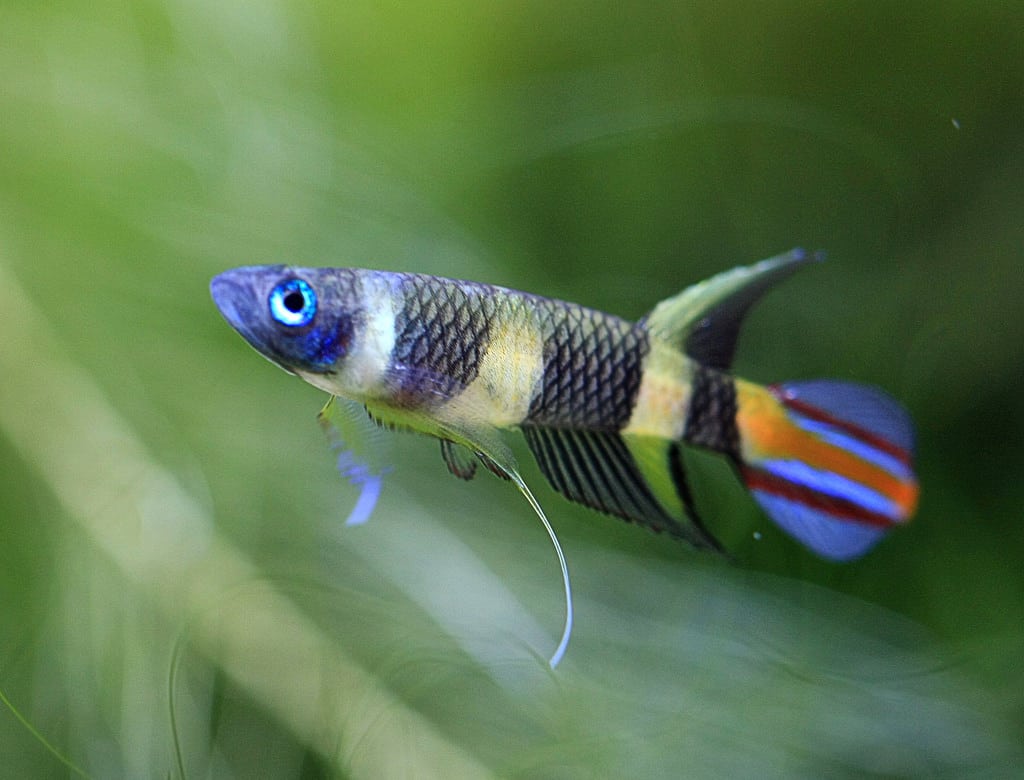
Breeding Clown Killifish
How to breed killifish? Reproduction is relatively easy, and well-decorated, mature species will begin to mate without mediation. However, if the adults are maintained in a community tank, it is best to arrange a separate fishpond for breeding Killifish. They need a suitable medium to keep eggs. Riccia, taxiphyllum species, Algae, floating plant roots, or woolly sprouting mops are equally suitable.
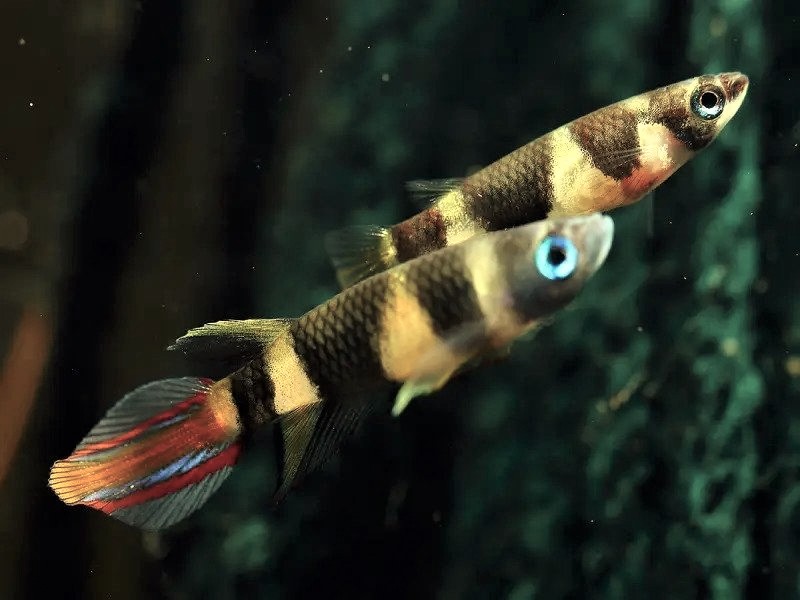
Most breeders use a pair or single male plus two or more females. Some prefer to remove and change the medium every few days, lay the eggs elsewhere, and free their swimming fry on the water surface.
Incubation is at 24-25 C / 75-77 F in 9-12 days.
If the fry is raised to a more sterile state, it will initially require micronutrients such as rotifers. The adults do not precede their offspring, but the old roast eats the younger ones, so must move to another location. It is important to avoid large vertebrates such as snails or shrimp from the breeding tank because they will ingest Epiplatys annulatus eggs.


